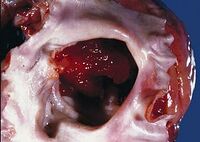Primary Tumors of the Heart
From WikiLectures

Embolus of cardiac myxoma in bifurcation of common iliac artery.
Primary heart tumors are significantly less common than secondary tumors
Benign Tumors[edit | edit source]
Benign tumors of the heart include:
Papillary Fibroelastoma[edit | edit source]
Warty or tassel-like formation on the heart valves.
Cardiac Myxoma[edit | edit source]
In 80% of cases, it is located in the left atrium, in 15% of the cases in the right atrium. The remaining 5% are located in the left or right ventricles.[1]
- Clinical Signs
- In case of embolism: ischemia of organs supplied by the embolized artery
- In case of mitral obstruction: dyspnea, fatigue, cough, hemoptysis, pulmonary edema
- In case of tricuspid obstruction: symptoms of right-sided heart failure
Cardiac myxoma can be accompanied by a variety of non-specific symptoms
- Diagnostics
- Patient's history
- Physical examination
- Echocardiography
- Treatment
- Surgical removal
- Echocardiographic monitoring
- Carney Complex
= syndrome of complex myxoma
- This is a rare syndrome in which cardiac myxoma is associated with:
- Multiple pigmented nevi
- Adrenocortical hyperplasia
- Pituitary tumors
- Multiple fibroadenomas of breasts
- Sertoli cell tumor
- Skin myxoma
Rhabdomyoma[edit | edit source]
Malignant Tumors[edit | edit source]
Sarcomas[edit | edit source]
- Angiosarcoma, rhabdomyosarcoma (fibrosarcoma, liposarcoma, osteosarcoma)
- It can occur at any age
- Most often in the myocardium of the right atrium
- Clinical notes: it can manifest as heart failure, arrhythmia, pain in the precordium, pericardial effusion, cardiac tamponade, sudden cardiac death, embolization (tumor masses, thrombi; often to the CNS), pulmonary edema, and/or syncope (when the tumor is located in left atrium); extracardiac metastases (lung, mediastinum, spine, etc.); prognosis is very poor (about 3 months of life).
- Diagnostics: weight loss, blobbing fingers, heart failure, arrhythmia, pericardial friction murmur, diastolic murmur at the tip/regurgitation systolic murmur; mainly ECHO, CT, and MRI.
- Treatment: surgical removal, but in most cases it is only palliative
References[edit | edit source]
Related Pages[edit | edit source]
Citations[edit | edit source]
- ↑ VANĚK, Ivan. Kardiovaskulární chirurgie. 1. edition. Praha : Karolinum, 2003. 236 pp. ISBN 8024605236.
Sources[edit | edit source]
- KLENER, P, et al. Internal Medicine. 3rd edition. Prague: Galén, 2006. ISBN 80-7262-430-X .
- VANĚK, Ivan. Kardiovaskulární chirurgie. 1. edition. Praha : Karolinum, 2003. 236 pp. ISBN 8024605236.



